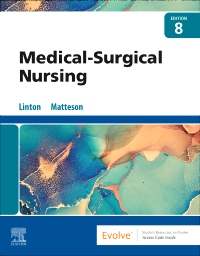
Evolve Resources for Medical-Surgical Nursing, 8th Edition
Resources

Educator Resources on Evolve
- TEACH lesson plans
- PowerPoint® slides
- Image collection
- Test bank
- Answer key for study guide exercises
- Answer key – Study Guide
- Conversion guide
- Suggestions for working with English-as-a-Second-Language students
- Next-Generation NCLEX™ (NGN)-style case studies
Student Resources on Evolve
- More than 600 NCLEX-PN® review questions
- Fluids & Electrolytes tutorial
- Answer keys to in-text NCLEX review questions, nursing care plan critical thinking questions, and Put on Your Thinking Cap questions
- Laboratory reference values appendix
- Spanish-English glossary
- Bibliography
-
UNIT I: Medical-Surgical Nursing
1. Aspects of Medical-Surgical Nursing
2. Medical-Surgical Practice Settings
3. The Nursing Process and Critical Thinking
UNIT II: Populations Receiving Medical-Surgical Care
4. Medical-Surgical Patients: Individuals, Families, and Communities
UNIT III: Pathology Processes and Effects
5. Health, Illness, Stress, and Coping
6. Immunity, Inflammation, and Infection
7. Fluid, Electrolyte, and Acid-Base Balance
8. Cancer
9. Pain
10. Shock
UNIT IV: Special Problems of the Older Adult Patient
11. The Older Adult Patient
12. Falls
13. Immobility
14. Delirium & Dementia
15. Incontinence
UNIT V: Therapeutics
16. Nutrition
17. Intravenous Therapy
18. Surgery
19. Ostomy
20. Palliative and Hospice Care
21. Complementary and Alternative Therapies
UNIT VI: Neurological System
22. Neurological System Introduction
23. Neurological Disorders
24. Cerebrovascular Accident
25. Spinal Cord Injury
UNIT VII: Respiratory System
26. Respiratory System Introduction
27. Upper Respiratory Disorders
28. Acute Lower Respiratory Disorders
29. Chronic Lower Respiratory Tract Disorders
UNIT VIII: Hematologic and Immunologic Systems
30. Hematologic System Introduction
31. Hematologic Disorders
32. Immunologic System Introduction
33. Immunologic Disorders
UNIT IX: Cardiovascular System
34. Cardiovascular System Introduction
35. Cardiac Disorders
36. Vascular Disorders
37. Hypertension
UNIT X: Digestive System
38. Digestive System Introduction
39. Upper Digestive Tract Disorders
40. Lower Digestive Tract Disorders
41. Liver, Gallbladder, and Pancreatic Disorders
UNIT XI: Urologic System
42. Urologic System Introduction
43. Urologic Disorders
UNIT XII: Musculoskeletal System
44. Musculoskeletal System Introduction
45. Connective Tissue Disorders
46. Fractures
47. Amputations
UNIT XIII: Endocrine System
48. Endocrine System Introduction
49. Pituitary and Adrenal Disorders
50. Thyroid and Parathyroid Disorders
51. Diabetes and Hypoglycemia
UNIT XIV: Reproductive Systems
52. Female Reproductive System Introduction
53. Female Reproductive Disorders
54. Male Reproductive System Introduction
55. Male Reproductive Disorders
56. Sexually Transmitted Infections
UNIT XV: Integumentary Systems
57. Integumentary System Introduction
58. Skin Disorders
UNIT XVI: Special Senses
59. Special Senses Introduction
60. Eye and Vision Disorders
61. Ear and Hearing Disorders
UNIT XVII: Medical-Surgical Patients with Psychiatric Disorders
62. Psychobiologic Disorders
63. Substance Abuse
UNIT XVIII: Nursing in Disasters and First Aid
64. First Aid, Emergency Care, and Disaster Management
-
This product is available in the following formats:



















 as described in our
as described in our 